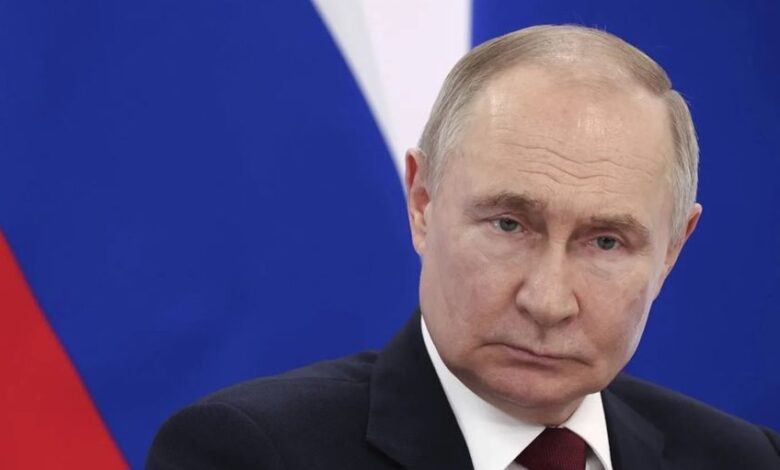Moscow’s “Red button” … What is the theory of Ruwin …


“Russian Nuclear theory” – its official name “the basics of state policy in the field of nuclear prevention” – a document that reflects the Russian view in the Nuclear Power Prevention Sector, and the conditions for the use of nuclear weapons and its nuclear weapons repository.
Throughout its history, it was part of the “Russian military theory”, which was announced in 2000 by Russian President Vladimir Putin, and became a separate document in 2020.
In 2024, Russia made amendments, especially to reduce restrictions on using its nuclear weapons repository to prevent Moscow’s enemies.
History of Russian nuclear theory
On November 2, 1993, Russian President Boris Yeltsin issued a decree on “the basic principles of Russian nuclear principles”, and it was the first official gesture of the state that regulated the use of the Russian nuclear weapon, but it was not released.
On April 21, 2000, Russia declared its first civilian confidence in which it was considered a factor in preventing the occupation of nuclear weapons and ensuring the military security of the Russian Federation and its allies.
The second military document was released on February 5, 2010, in which President Dmitry Medvedev signed. The third amendment of the military theory was published on December 25, 2014, and the nuclear weapons regulations were not changed to any change, but rather an important factor in preventing the appearance of nuclear military conflicts and others.
3 documents include the possibility of using a traditional weapon that threatens its nuclear weapons of its nuclear weapon against it or with mass destruction or state of the state.
In the second document, NATO included in the threat field, only the president’s reservation for the use of nuclear weapons. Among the most important objects of nuclear theory included in three documents:
The provision of land and resources to support the aggression against Russia is one of the main reasons why Russia can use a nuclear barrier against its owners.
One of Russia’s most important priorities is to prevent enemies from starting an occupation in the country.
Russia’s desire and determination to use nuclear weapons will ensure any nuclear occupation.
Nuclear weapons are needed to launch ballistic missiles in Russia.
Russia has the right to use nuclear weapons in response to the use of mass destructive weapons against them or its allies.
The Russian president makes the decision to use nuclear weapons, and he can report to countries and international organizations about the desire to respond to his country.
The amount and location of Russia’s nuclear weapons, a part of the nuclear prevention, aims to stop the potential expansion or attack.
Correction for 2020
Nuclear weapons were a preventive and protection method for Russia, until Putin signed a decree to divide the “nuclear doctrine” by 2020, and its terms include changes in its terms, and accordingly Russia decides to use nuclear weapons:
Getting reliable data that ensures the purpose of shooting ballistic missiles towards the territory of Russia or its allies.
Any catastrophic weapons, which include nuclear, chemistry and biological weapons and unusual weapons, are attacked by Russia or one of its allies.
Russia can use its nuclear weapons repository, even if traditional weapons, but if this target threatens the presence of the state.
If sensitive government or military bases are subjected to the enemy’s attack, the Russian nuclear theory allows the nuclear weapon to respond.
Correction for 2024
On November 19, 2024, Moscow announced its renewal of its nuclear confidence, after the US gave Ukraine a green lamp to use long -term American adances missiles to hit military targets within Russia.
Putin signed a modified edition of the doctrine of the Thousand Days since the beginning of the Russian war on Ukraine, and the first use of nuclear weapons would reduce Russia’s theory, Kremlin said.
Of the most important items included in the revised document:
The non -nuclear state with the participation or support of the nuclear government is a joint attack by a non -nuclear state or any aggression against its allies.
Russia may consider a nuclear strike if it is occupied or used by “traditional weapons that threaten their sovereignty or regional protection” or its friendly paralosia.
Russia can use nuclear weapons if an enemy is under nuclear attacks or if the state’s existence is under traditional attack.
Widespread air strikes can lead to nuclear respondents with aircraft, guided missiles and drones that cross Russia’s borders.
Any member country is considered the occupation of the entire alliance in a coalition against the Russian Federation or its allies.
The enemy’s garden is likely to be used against Russia, which can lead to a nuclear response.
With the aim of providing nuclear weapons, mobilizing a group of lands close to Russia or its allies, which may require nuclear respondent.
The spread of the enemy of missile security systems in space is the risk of nuclear prevention use.
Planning and conducting large-scale military exercises near Russia’s borders can lead to a nuclear response to a nuclear response.
